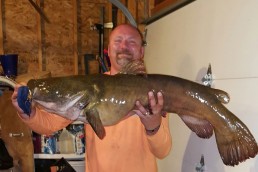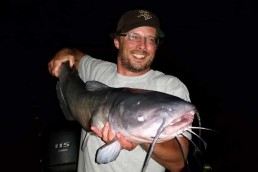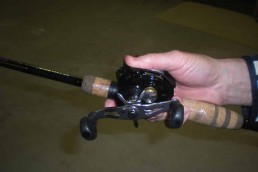Cattin’ on the Wolf
SHARE THIS POST
Catfishing on the Wolf River is a relaxing experience that can be enjoyed by everyone including loved ones or your favorite fishing buddy. It can also be very productive here, as you can catch several meals.
The channel cats in this river average 5 to 6 pounds, while the big channels in the Winnebago system can run 17 pounds. The channel cats are the best fighters in the system, though the flatheads battle well too. The flatheads here are a protected species in the Winnebago system so there is a special season and a slot limit. Keeper flatheads are 30 to 36 inches and are over 42 inches long with the average 42-inch flathead weighing 40-plus pounds.
Channel cats and flatheads have somewhat similar, but different locations depending on the time of the day. Most of my catfishing is done at night, and I fish shallow flats above a deep hole or above a logjam; during the day I fish logjams and deep holes. Most deep holes on the Wolf are on the outside corners.
One prime time for channels and flatheads is when the white bass start to come upstream. Late April is normally when to start fishing them, when the water temperature is starting to rise. Late April through May is prime feeding time for the breeding channel cats, when they have plenty of food to gorge on before the spawn. Flatheads are similar in timing, with the season for them opening the first weekend of May and ending September 30. They are hungry before the spawn and even more so afterward.
Are you enjoying this post?
You can be among the first to get the latest info on where to go, what to use and how to use it!
For catching channel cats, I use my sliding “Wolf River rig” that includes a couple two-way swivels, a drop line to a sinker and a leader to the circle hook. For channels, I use a 1 or 1/0 circle hook and the lightest sinker possible to hold the bait in place. The leader to the hook is 24 to 36 inches and the drop line to the sinker is at 8 to 12 inches. Medium to medium-heavy rods and 10- to 30-pound-test braided line are suggested for the channel cats. The best baits are chicken livers, cut minnows, stink baits, cut up shrimp and spawn sacs from fish. I search for them using a rod holder set at a 45-degree angle, which is key when using a circle hook. These cats will grab the bait and run, and a circle hook and rod holder will set the hook for you while you enjoy the fight.
For flatheads, I use the same rig but with much heavier equipment. Medium- to extra-heavy rods with 50- to 100-pound-test braid line, 3-ounce weights and 3/0 to 7/0 circle hooks do the job. The sinker drop line is 18 to 24 inches and the leader to the sinker hook is at 30 to 40 inches. As far as bait, I’ve had luck with 4- to 8-inch bluegills and rock bass or 6- to 12-inch suckers. The key to landing these flatheads is a bait clicker, which allows line to free-spool without causing a backlash, plus it alerts you to a bite. I lay my rods flat in the rod holders with the bait clickers on, and free-spool on, and with the rods locked in place. If the bait clicker goes off, I wait and see; if it’s running steady, I set the hook, slowly raising the rod tip to the 12 o’clock position. If it’s running slowly, I just wait longer to set the hook. Patience in the moment is certainly a virtue, and with only one circle hook on your line, the timing needs to be right. And if you get it right, you’re in for a battle. But if it’s wrong, you may have to wait for another bite, but even then it’s still worth the extra wait.
Catfishing is an excellent way to spend time on the water whether you’re trying to catch a meal, enjoy the outdoors or just relax in a boat. Catfish are excellent for eating out of this system too when smoked, blackened, and pan-fried or deep-fried. For the flatheads, I’ll butter-poach them or deep-fry them. Flatheads in my opinion are the best eating fish in the entire Winnebago system.
MWO
SHARE THIS POST
Did you enjoy this post?
You can be among the first to get the latest info on where to go, what to use and how to use it!
Captain Patrick Morack
MidWest Outdoors works with more than 200 outdoor experts each year, who contribute articles based on their areas of expertise. MidWest Outdoors magazine offers more fishing and hunting articles than any other publication!



